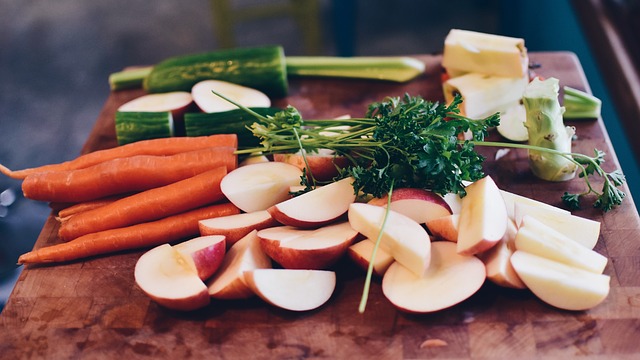Pick the freshest seasonal vegetables you can find. Eat them as fresh as you can. The longer they are exposed to air, heat and water, the less nutritious they will be.
“Fresh” vegetables shipped from long distances and displayed for several days in a store may actually be less nutritious than those that are flash-frozen shortly after harvesting. Go for locally grown if possible.
After taking them home, wash them thoroughly, drain them, and seal them in a zip-locked bag and store in the refrigerator so you can use them anytime to make a quick snack or dish.
Cooking Methods:
Experiment with a variety of cooking methods like steam, boil, sauté, water sauté, pressed salad, or waterless cooking.
Steaming
Steaming is a simple way to cook your vegetables. It is especially helpful to get to know them, how they taste in their most simple and pure form. Steaming makes greens more fibrous and tight; great for people trying to lose weight.
(But it require more chewing) Nutrients are locked in the greens by steaming. Steaming takes 5-10 minutes to prepare green leafy vegetables, and 10-25 minutes to prepare roots. What you need is a steaming basket and a pot with lid filled with about two inches of water.
Waterless Cooking
Waterless cooking is cooking without water. Traditionally, most cooking has been done in water. Some say that cooking in water often takes out many of the nutrients, and downgrades the flavor of the food.
A method to avoid losing the natural nutrition of the food is to cook it in a near-waterless environment, using the food’s natural juices.
A surprising feature of waterless cooking is that cooking is easy and seems to take less time. Since the heat is evenly distributed, there is no burning or sticking, making the pots easier to clean.
You also don’t have to use oil to prevent sticking. Since the food cooks in its natural juices, it tastes terrific and has more vitamins left in it.
This usually requires special cookware such as stainless steel with a flat bottomed surface. There is a special lid that prevents ‘foods’ natural water from evaporating, therefore it steams and cooks itself.
The foods don’t burn because this cookware has special features like an iron core to retain and evenly distribute the heat to the food. Good method, but keep in mind that cookware is relatively costly.
Quick Boil
When quick boiling vegetables, just dip them in boiling water and leave for 3-5 minutes. This method removes their raw flavors, makes them more digestible and brightens up color.
When you’re done boiling rinse with cold water to stop additional cooking and preserve the bright color of the vegetables.
Boiling makes greens plump and relaxed. Drink the cooking water as a broth or a tea because it contains water soluble nutrients from the greens.
Boiled greens are usually more pleasant to eat than steamed ones. In average 30% of the nutrients (vitamins and minerals) are lost in boiling but since greens are so high in nutrients to start with, the loss is not to be worried about.
Putting in a pinch of salt into the boiling water keep the vegetables looking really green.
To Make Boiled Or Steamed Greens More Interesting:
• Sprinkle with toasted pine nuts, other nuts or raisins
• Sprinkle with sesame seeds and dress with (toasted) sesame oil or flaxseed oil
• Sprinkle with freshly squeezed lemon juice
• Sprinkle with gomasio
• Dress with Umeboshi vinegar/high quality soya sauce
Sauteing Or Quick Stir Fry
Stir-frying is another quick and nutritious way to prepare vegetables. You can stir-fry in oil, or in water.
This method makes vegetables really tasty since hot oil seals in flavour. You can use all vegetables, and be aware that the softer the vegetables are, the less they take to cook.
Start with the vegetable that takes longest to cook.
What you need is a skillet with lid.
If you choose to use oil, use a good quality extra virgin olive oil. For longer cooking time (higher temperature, use organic coconut oil, sesame oil (has distinct flavour) or sunflower oil. Heat a skillet and add 1/2 cup oil.
Add vegetables, and sprinkle them with a pinch of sea salt – that will make them taste sweeter and draw enough moisture to avoid sticking. If you stir-fry with oil you can sprinkle water over your vegetables to gain extra steam and heat, and it looks very professional!
If you choose to water sauté, add 1 inch of water to your skillet, and bring to boil. Add thinly sliced vegetables, cover and simmer for 5-10 minutes.
Variations:
For added “warmth” or to make vegetables more satisfying especially in winter times: stir-fry with ginger root and/or garlic; or dip steamed vegetables in a healthy sauce eg. Lemon Tahini sauce or Pumpkin Seed sauce.
Baking
Certain vegetables taste best baked. Baking brings out the very essence of the vegetables, especially squashes and roots. You need a baking pan with lid, your vegetables and your oven, between 375-450 degree heat for 50-60 minutes.
Eating Vegetables Raw
Of course raw salad is good with all the life enzymes intact, but not all the time. Heating the greens helps soften the cell walls making the nutrients more available for your body to absorb.
Also, the cooking helps eliminate parasites that may be in or on the food. When eating greens raw, go for organic and make sure the washing is thorough.
You can find much more information on living a holistic lifestyle in these free magazines and on our YouTube channel.
Lakshmi Harilela – www.lovetruefood.com






